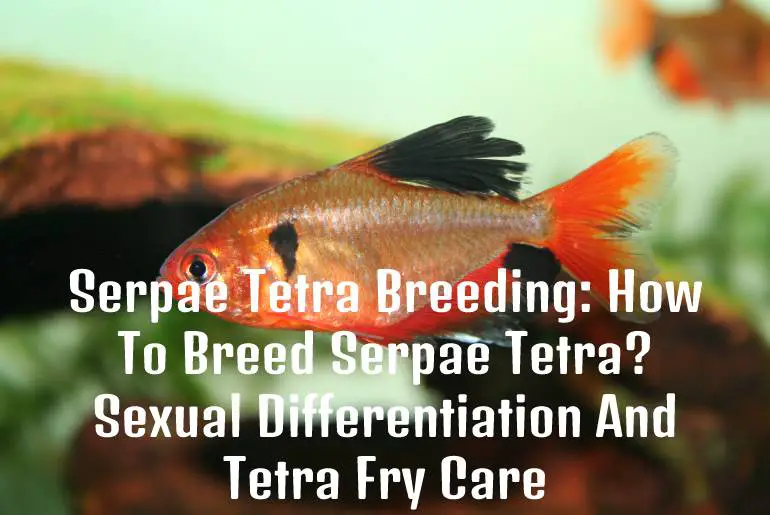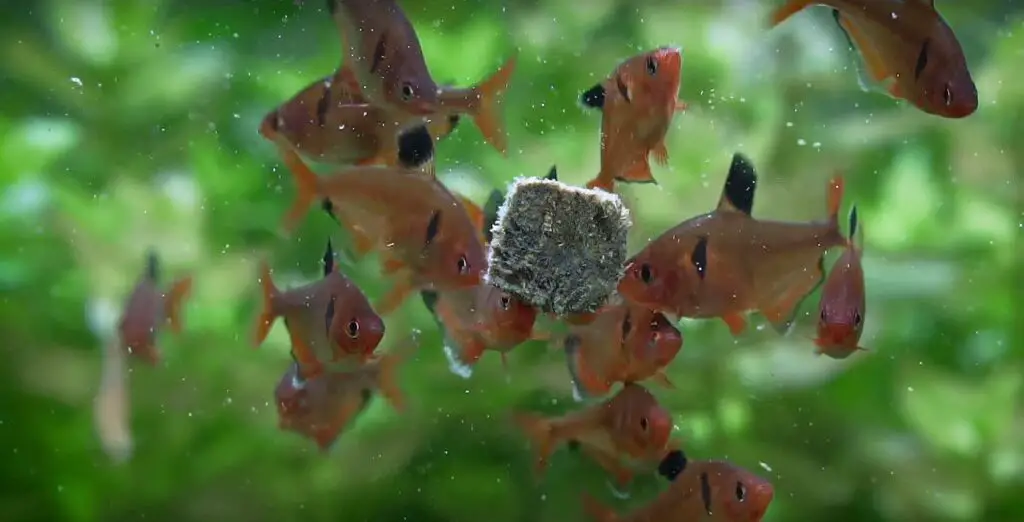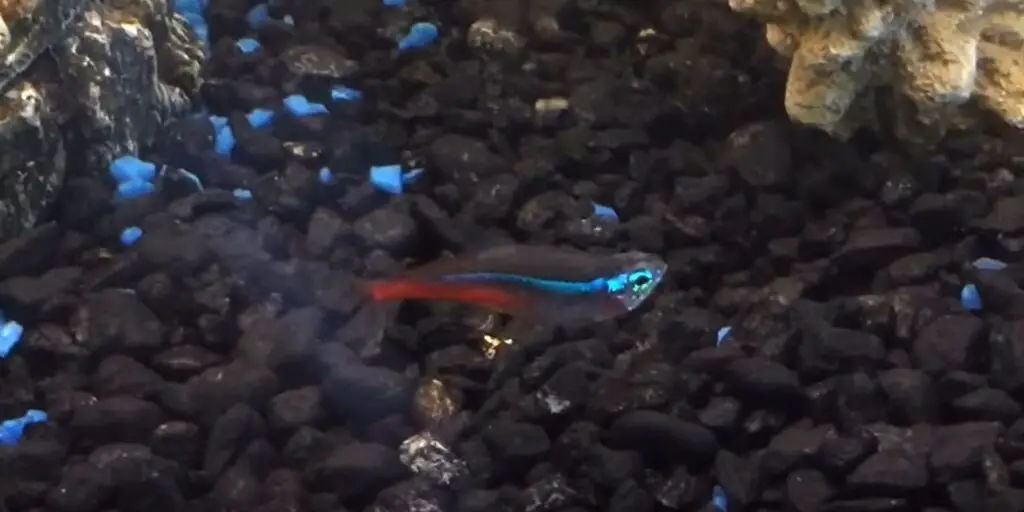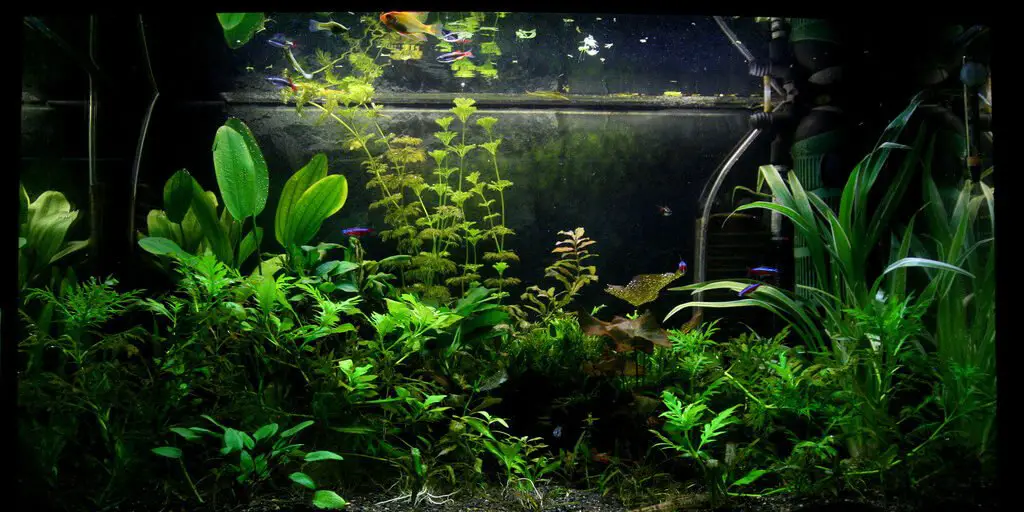Who doesn’t want to have small tetra babies swimming around in the tank? I genuinely love seeing small tetra fry swimming around and growing rapidly. They actually surprised me most of the time when I see them growing into adults within the interval of few months. But to have small tetra fry in the tank, you need to know how to breed them? And of course, the beauty of Serpae tetra will attract you into breeding them in the tank. However, do you know what should you do while breeding Serpae Tetra?
Breeding Serpae tetra is no rocket science, trust me. You need to prepare the breeding tank and maintain the ideal water parameters along with choosing the best breeding pair of Serpae tetra to make them breed properly. These egg-layers will spawn and give you cute little fry which in turn you will have to take care of.
But this piece of information will do no good unless you read in detail about all the steps you need to take.
In this article, I have tried to collect all the information related to breeding Serpae tetra, their gender differentiation, and of course their eggs and tetra fry care.
Let’s dive in to know all about Serpae tetra, Shall we?
Things You Will Need While Setting Up The Breeding Tank For Serpae Tetra
Before taking any further steps, I will hand you out the list of things you will need while setting up the tank for breeding purposes.
I know you might be thinking about the extra expense due to breeding Serpae tetra. But if you want to have healthy and alive fry in the tank, then please do as I say and recommend.
- Breeding Tank
- Tank Lid
- Heater
- Sponge Filter
- Spawning Mop
- Plastic Grate
- Test Kit
- Thermometer
- Peat Moss
- Plants
- Aquarium Light
Breeding Tank Requirements Of Serpae Tetra
While preparing for the breeding you need to make few things ready before you make your fish ready to breed.
These things are quite vital and you should not miss out on any of the things I will point out here.
You might like to read a full article on How To Set Up Breeding Tank For Tetras?
Tank Size
First of all, you need to get a separate tank to breed Serpae tetras. You can’t keep them in the tank with other fish as other fish might disturb the spawning process or even eat up all the eggs.
A similar-sized tank or a 20-gallon to 10-gallon tank will be the best tank size for breeding Serpae tetra fish.
Filtration And Cleaning The Tank
Cleaning the tank is quite important when it comes to breeding tanks. You need to install the filter beforehand and let the tank mature properly.
Clean the tank so no bacteria or parasite stays on the tank. After cleaning the tank, install a sponge aquarium filter and fill the tank with clean and chemical-free water.
You need to use a sponge filter specifically so that the eggs or small fry don’t get sucked up into the filter.
I highly recommend you to get hygger Aquarium Double Sponge Filter, Comes with 2 Spare Sponges, 1 Bag of Bio-Ceramic Media Balls, Quiet Submersible Foam Filter for Fresh Water and Salt-Water Fish Tank
The presence of ammonia, nitrite, or any other pollutants can hamper the breeding process. You can test the ammonia and nitrite level with a help of the API Aquarium Test Kit.
The excretion of the Serpae tetra and dead leaves are the prime cause of this. So, it is quite necessary to clean the tank, remove the debris, and filter out all the pollutants from the breeding tank.
You might like to read more about How to Clean a Tetra Fish Tank? [Step-by-Step]
Breeding Pair
You need to purchase a healthy and disease-free pair so that you can get healthy eggs as well as fry later on.
Temperature
You need to maintain a definite temperature that is slightly warmer than usual in the tank. The temperature of the breeding tank needs to be 80 degrees Fahrenheit.
You can easily get AQQA Mini Submersible Aquarium Heater from amazon.com. This heater will help you obtain the ideal temperature and maintain it too.
The right temperature will develop the urge in Serpae tetra to breed and also the fluctuation in temperature can affect these Serpae tetras as they are sensitive during the breeding phase.
pH
You need to keep on testing the water so that the pH doesn’t fluctuate. The fluctuation in the pH of the tank water can affect the Serpae tetra in the same way temperature fluctuation does.
The pH level of the tank needs to be towards the Acidic side, 6.0 to be precise. During this time, an API Aquarium Test Kit will come in handy.
Hardness
The breeding tank needs to have soft water as Serpae tetras need softer water while breeding. The water hardness needs to be between 6 to 8 dGH.
Decorations
You need to keep things, decorations, and substrate that will give comfort and safe space to Serpae tetras.
A plastic crate or spawning mop will be a great addition to the breeding tank to save eggs from being eaten.
Driftwood will also be a good choice for decoration as it will help you lower the pH as well. PIVBY Natural Aquarium Driftwood Assorted Branches Reptile Ornament for Fish Tank Decoration Pack of 3 is what I recommend to most of my friends that have breeding aquarium or aquarium in general.
Go for the darker substrate that will mimic the natural habitat of Serpae tetras. ADA Aquasoil Amazonia will be the perfect substrate for your Serpae tetra breeding tank.
Plants
Serpae tetra loves having plants in their breeding tank. You might be prepared with all the plastic grate and spawning mop but trust me these all preparations will fail once they see plants in the tank.
Serpae tetra will end up laying eggs on the leaves of the plants. Even the male Serpae tetra will woo the female tetra into laying eggs on the leaves of plants.
Java Moss or Myriophyllum will be a great addition to the breeding tank of Serpae tetra. Trust me, you will love the look this plant will provide to the tank and support to tetras while laying eggs.
There are few more plants that you can keep in the tank with tetras. Here is an article to help you with this query: 10 best plants for the tetra tank.
Lighting
Serpae tetra doesn’t need light in the tank, actually, it will be great if you keep the lighting to a minimum. A dim-lit environment will be great while breeding Serpae Tetras.
Tetra Hidden LED Stick Light for Aquariums, Brilliant White will help you attain this. Buy it!!!
Diet
You need to feed them an adequate diet and a little more than usual. A well-fed Serpae tetra will breed sooner than usual.
It is better to provide than live foods more rather than commercial flakes or pellets. Live foods provide them more nutrients that they will need during breeding and laying eggs.
How Can You Tell If A Serpae Tetra Is Male Or Female? Sexing Serpae Tetra/Gender Differentiation
Tetras are quite hard to differentiate when it comes to their gender. Even some tetra species look the same.
So, can you imagine the toil when it comes to differentiating Male tetra from Female tetra?
Not easy work, boss. But hey, do you think I will disappoint you? Definitely not. So, here is what you have to do.
- Look at the color variation between the Serpae tetra you have. Male species of Serpae tetra are brightly Colored than female ones.
- The color of the dorsal fin will give away the gender too. The male Serpae tetras have fully black dorsal fin while female Serpae tetras have slightly lighter ones.
- Now, look at the body and size of your Serpae Tetras. Male Serpae tetras are quite slimmer than female ones.
- The gender is most evident when these tetras are ready to spawn. Female Serpae tetra will become plumped with eggs and trust me it is easily noticeable.
How To Breed Serpae Tetra In The Tank?
You need to know how to breed or make them spawn in the tank. So, there are few things you need to do when you plan to breed Serpae Tetra.
Once you finish the tank preparations for breeding Serpae tetra, you need to look at few things beforehand as well.
You can’t risk the breeding process as Serpae tetra tend to be way more sensitive and fragile during the breeding season.
Let me help you and take you through the step-by-step process of breeding Serpae tetra in the aquarium.
Keep Breeding Pair Of Serpae Tetra In The Separate Tank
You need to keep a pair of Serpae tetra, both male and female, in a separate tank prepared for a specific breeding purpose only.
You need to check whether the breeding pair is healthy or not. Sometimes, a sick Serpae tetra, when kept in an environment as energy-consuming as breeding, will die off soon.
So, if you want to have a good end product from breeding, then keep the breeding pair in a separate tank.
No other fish can disturb them or harm them during the breeding season when you keep these Serpae tetras in a separate tank.
Bullying or even the presence of other fish in the same tank cannot stop or disturb the breeding pair and the spawning process will never be complete.
High Protein Diet For The Breeding Pair Of Serpae Tetra
As I said earlier, these tetras are weak during the breeding season. Especially female tetras will suffer more so they might need more food than usual.
Make sure you provide them high-protein diet as well as varieties of food so that they do not lag behind due to low immunity power.
A well-fed tetra will be more active and eager during the breeding phase. To be honest, more food to both these tetras in the breeding tank will speed up the spawning process.
Spawning Environment
Make sure the temperature is optimum and the pH level is well-maintained. Do not let any ammonia, nitrite, or other harmful chemicals stay on the tank.
Filter out all the impurities as soon as possible and let the lighting remain towards the dimmer side. You will find your breeding pair mating when all the water parameters are met.
Breeding Ritual Of Serpae Tetra
The courtship dance of male Serpae tetra is quite different and unique if you ask me. Once they see plants in the tank and when the water parameters are optimum, the urge to breed dominantly releases in males.
The male will then try to woo the female Serpae tetra by vibrating around them and call or entice them towards the plants.
As you know, Serpae tetra is fond of plants. So, when the male tetra come across plants and good food, they will start to impress female tetra to woo them into laying eggs.
They will dance around female Serpae tetra as if they are vibrating at certain intervals for a while.
If you see your male Serpae tetra revolving around the female doing their vibrating, be prepared to see some eggs in the tank.
How To Identify Pregnant Serpae Tetra?
Well, first of all, you need to understand, egg-laying fish like Serpae Tetra cannot get pregnant. There is a difference between being pregnant and being gravid with eggs.
You might be interested to know more about Are Tetras Egg Layers? What Do They Look Like?
Yes, you will find certain changes in the body structure of female Serpae tetra when they have eggs in them.
But your Serpae tetra cannot get pregnant like livebearers. You see livebearers are the ones that will carry their babies in their belly.
Learn more about Are Tetra Livebearers? Do They Give Birth or Lay Eggs?
However, Female Serpae tetra will carry the eggs until the spawning season starts. The way to tell if these tetras are pregnant or not is to look closely at their bellies.
The egg-carrying fish will look slightly heavy as well as fat towards the belly. This is also a way to tell the difference between male and female Serpae Tetra.
What Does Serpae Tetra Eggs Look Like?
Once the breeding ritual completes, female Serpae tetra will lay eggs on the leaves of the plants present in the tank.
Male Serpae tetra will fertilize the egg almost immediately. Now, you must be worried about the safety of eggs and of course, you need to know the appearance of eggs too.
If you follow the breeding ritual of the Serpae tetra, you will find the female Serpae tetra laying eggs. These eggs are whitish or cream-colored and will stay in a cluster of hundred each time.
The fertilized eggs will have a black dot in the middle while the unfertilized eggs will remain the same whitish or cream-colored.
How Many Eggs Do Serpae Tetra Lay?
To be honest, no tetras are different when it comes to the number of eggs they can lay. Each time a female Serpae tetra can lay hundreds of eggs in the cluster.
The number varies from 50 to 150 depending on the ovulation of female Serpae tetra. But don’t worry, not all the eggs will hatch into fry.
Most of them will not be fertilized or even develop properly. You will end up with 20 to 30 percent of fry from the total number of eggs Serpae tetra lay.
How To Take Care Of Serpae Tetra Eggs In The Tank?
Once you see your Serpae tetra laying eggs in the tank and of course the male fertilizing them immediately, you need to worry about something else.
Taking care of eggs is one of the important steps while breeding Serpae tetra. If you lose these eggs, you will never get Serpae tetra fry in the tank.
So, read these instructions carefully if you really want to see small fry swimming around in the tetra tank.
Remove The Adults From The Tank
As soon as female Serpae tetra lays the eggs and male Serpae tetra fertilizes them, you need to remove these adults from the tank.
These tetras don’t have the parental instincts and will eat their eggs while roaming around in the tank. This is an unintentional and unknown act but still, they will not leave any egg behind.
So, in order to keep these eggs safe till they hatch properly, you need to transfer adult Serpae tetras back to the main tank.
Let the eggs sit alone in the breeding tank till they hatch into tetra fry. This is the simplest way to save your Serpae tetra eggs from the adults that will eat anything that fits in their mouth.
Decorations In The Tank
There are some decorations you can install in the tank to keep the Serpae tetra eggs safe from adult fish or any other aquatic being present in the tank.
Marble floor, spawning mop, or plastic grate, any of these things will help you hide the eggs.
Once the female Serpae tetra lays the eggs, these eggs will sink down to the bottom of the tank.
So, you need to provide an appropriate place for the eggs to settle in. If you leave them laying in the substrate, your adult fish will eat them up while scavenging through the bottom.
Maintain The Water Parameters
People often think an adult will be affected by improper water parameters and eggs won’t mind the change.
Let me tell you how wrong they are. Have you ever seen a chicken protecting her eggs and keeping them warm?
They do so to keep their eggs safe and let the chicken hatch properly and healthy. The same thing happens with the eggs of fish.
Since Serpae tetra will not take care of their eggs, you need to maintain the appropriate condition in the tank.
Look closely at the temperature of the tank and don’t let it fluctuate. Similarly, do not let the waste products or excretion of adult fish stay in the tank.
Remove these as soon as you remove the adult fish. Aquarium ammonia poisoning or even the slightest hint of ammonia will cause serious damage to the eggs.
Use Sponge Filter
The water current of other filters can suck up the eggs into the filter during the filtration process. However, a sponge filter will block the suction of eggs outside the tank.
So, please stick with a sponge filter till the eggs hatch and grow into adults that cannot be pulled up by the filter water flow.
Low Lighting
The eggs of Serpae Tetra are highly sensitive to the high output of light or even light in general.
So, once you transfer the adult Serpae tetra back to the main tank, turn off the light and cover the tank with a towel.
This way no light will enter inside the tank and your Serpae tetra eggs will be safe and sound. Even the slightest damage to the eggs will lead to the no tetra fry in the tank.
Serpae Tetra Fry Care
If you are caring enough to save the eggs during the whole process, then you will start to fry in the tank. The eggs of Serpae Tetra will hatch after 2 days but your work doesn’t end here.
Now, you have to be extra careful with small details in the tank and do not miss any opportunity to nurture the newly-born fry.
You have to do few things in the Serpae tetra fry tank too if you want tetra fry to grow properly. Patience is the key here.
Follow my lead and you will end up having dozens of Serpae tetra ready to sell or pet, the choice is yours.
Read a full article on How To Make Tetra Fry Grow Quickly?
Maintain The Tank Water Parameters
Do not let your guard down just because the eggs are hatched. Tetra fry will be fragile and are quite sensitive to water parameters.
You cannot sit back and rest till these tetra babies are strong enough to protect themselves through inconsistency.
The water temperature, pH, as well as hardness of the water, needs to be optimum and no changes will be endured by your new tetra babies.
Think about it, if adult tetras get stressed and develop the disease when the water parameters are not maintained, what will happen to the newly-born fragile Serpae Tetra Fry?
Feed Them Proper Diet
Do not rush to feed food to the newly-born Serpae tetra fry. The yolk sac present with them even after the end of the hatching process will provide them food for few days.
The right time to start feeding your Serpae Tetra fry is when you will find these babies swimming freely in the tank.
But still, stick with the Infusoria and brine shrimps as the food of Tetra fry. Your Serpae tetra fry will not be strong enough to digest adult foods till they reach certain months of age.
Here is an article you might like to read How To Feed Tetra Fish Fry Properly | Dos & Don’ts With Alternative Food.
Frequently Asked Questions
I know the questions don’t end here. So, I picked up some of the most asked questions for the FAQs section and have written answers to them down below.
Are Serpae Tetras Hardy?
Oh yes. Like any other tetra, Serpae tetras are hardy and will adjust in a wide range of water parameters. Their hardy and easy-to-care nature make them ideal fish for the beginner aquarist.
But be careful to not fluctuate the water parameters more often./ Do not push the limit of your fish just because you know they will endure it.
Constant fluctuation and change in water parameters can lead to stress, diseases, and death of Serpae Tetra present in the tank.
Do Serpae Tetras Eat Plants?
Yes, Absolutely. Your dear Serpae tetra will and does eat Plants. Serpae tetras are omnivorous and hence they will eat plants as well as meaty food with no complaints whatsoever.
Even in the wild, you will find these Serpae tetras nipping and nibbling the leaves of plants and enjoying their food.
Are Serpae Tetras Fin Nippers?
Sadly yes. Serpae tetras are well-known fin-nippers and make it harder or I daresay impossible to keep fish with long beautiful fins in the same tank as them.
One of the few Fin-nippers from the tetra family, Serpae tetra withholds the reputation of making life miserable for long-finned fish.
I strongly suggest you keep Serpae tetra with the fish that are similar in size as well as temperament and have shorter fins.
Conclusion
In a nutshell, Breeding Serpae tetra in the tank is not hard as people think it is. Most people get cold feet whenever there is ongoing talk about breeding fish in the home aquarium. To be honest, I find the fear absurd because if you know the steps, you will do great. Serpae tetras are easily adjusting and adapting to the tank life. So, breeding them will not be a problem if you maintain the ideal parameters and proper diet for both male and female Serpae tetras.
You need to be patient while raising or breeding tetra fish. The good end-product after a long wait and proper care is what makes you happy and your fish active.
You’ll do great if you follow the instructions I gave you. And if you still have queries, drop them in the comment box below.
Good Luck!!
Happy Fishkeeping!!!
Recommended Articles:
- Breeding Tetra Fish – Step By Step Guide
- How To Breed Glowlight Tetras – Step By Step Guide
- How To Breed Neon Tetras – A Complete Step By Step Guide
- Why Do Neon Tetras Die After Laying Eggs?




